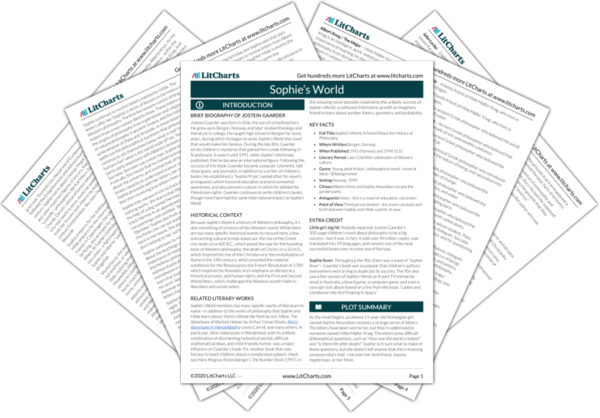Summary
Analysis
It’s early May in Norway, and a young woman named Sophie Amundsen walks home from school. She was walking with her friend Joanna, but Joanna’s house is closer to school than Sophie’s. Sophie walks through a dense forest on the outskirts of town to arrive at her home. When she arrives, she finds a letter addressed to her. She opens it and finds the words, “Who are you?”
The most basic philosophical question in this book—the one which provokes all the other ones—is the question of identity. Sophie is a young woman, unsure what kind of adult she’s going to grow up to be. During the course of the novel, she’ll come to terms with herself, in a way that can help to educate the reader, too.
Themes
Sophie’s letter has a strange effect on her. She remembers that her Mom and Dad had wanted to give her a different name—Lillemor, maybe. Sophie stares in the mirror and asks, “Who are you?” but gets no answer. Sophie often thinks about how ugly she is—she has straight hair and a big nose and mouth.
Sophie’s initial impressions of herself are superficial; those of a stereotypical, insecure teenager. Sophie doesn’t seem particularly brilliant, but she’s definitely thoughtful. Gaarder implies that there’s something about being young (still a teenager) that encourages herto immediately questionher place in the world.
Themes
Sophie goes outside, where she finds her cat, Sherekhan. She can’t stop thinking about the letter. She decides that she doesn’t really know who she is, and alsorealizes that she won’t be alive forever. This reminds her of her Granny, who died recently. It occurs to Sophie that one can’t really appreciate life without understanding death, and vice versa.
It’s sometimes argued that death is the phenomenon that inspires all of human thought—because we can’t live forever, we feel an irresistible impulse to understand life as well as death. The novel conveys this idea in the most literal terms: Sophie begins her philosophical inquiry by contemplating death.
Themes
Sophie walks inside, and notices another letter waiting for her: this letter says, “Where does the world come from?” Sophie realizes she doesn’t know the answer to this question either. This makes Sophie so upset that she decides to go to her secret“den”—the area where she likes to be when she’s confused, angry, or happy.
There’s a mysterious, whimsical tone to this novel—we have no idea who’s sending Sophie these letters, or how they could reach her so quickly. It’s interesting that Sophie already has her own special space where she can be alone with her thoughts.
Themes
Get the entire Sophie’s World LitChart as a printable PDF.

The narrator describes Sophie’s house—it’s red, with a garden outside. There’s a small gazebo outside, whichSophie’s grandfather built for Granny after their first child, Marie, who died shortly after being born. Sophie’s den turns out to be a small hole in the hedge by the house. Sophie sits in the hedge, holding her two letters. The hedge has always reminded her of the Garden of Eden, as she understands it.
Sophie’s den is her own secret place—the ideal space for her to contemplate things. There’s something lovely, but also naïve and immature about the fact that Sophie still has a hiding place at the age of 14—hence the nickname of her hiding place, the Garden of Eden (the site of the first innocent humans in the Bible).
Themes
Alone in the hedge, Sophie returns to the two questions in the letters. Sophie imagines that the world is a small planet floating in space. But this doesn’t explain where space comes from. In school, Sophie was taught that God created the world, but this just isn’t satisfying—even if God did create the world, who created God?
Gaarder has Sophie proceed rather straightforwardly, as he philosophical education generally follows the course of Western history. And before there’s philosophy, it’s suggested, there’s religion.
Themes
Sophie returns to the mailbox and finds a third postcard. The letter has a Norwegian stamp on it, and appears to be written in Sophie’s Dad’s handwriting. This confuses Sophie, since her Dad is far away, working hard at his job (captain of an oil tanker). Sophie sees that the card is addressed to someone named Hilde Møller Knag. The postcard explains (to Hilde), “I want to give you a present that will help you grow […] Forgive me for sending the card c/o/ Sophie,” and is signed, “Dad.”
Sophie’s Dad is a mysterious character—an absentee father who seems to care about Sophie, but rarely gets to spend time with her. It’s implied that Sophie’s inquisitiveness about the world is in some ways inspired by her father’s absence; it’s as if Sophie turns to philosophy as a way of counteracting her loneliness.
Themes
Sophie tries to make sense of what’s happened to her that day. She’s received three mysterious postcards, presenting three mysteries. She wonders who sent her the postcards, who Hilde Møller Knag is, and why she’s received Hilde’s birthday card. These three problems, she decides, must be connected in some profound way.
In this first chapter, Gaarder has introduced us to the important elements of his novel: a girl’s coming-of-age tale; a fantastical, “meta-fictional” work of a story-within-a-story; and a general study of philosophical questions and the history of Western philosophy.
Themes












